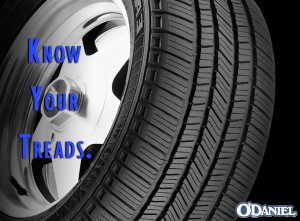Imagine driving down the highway when all the sudden your car slides out of control. Your heart begins racing, your stomach drops, and at the last minute the car comes to a screeching halt. You question yourself,” what just happened?” Hydroplaning is one of the top reasons to have good tread on your tires. And a good reason for you to understand what tires are, and how to evaluate tires.
Tires are made of five main components: Plies, Steel Belts, Bead and Chaffer, and Cap Plies. Plies are the backbone of a tire. According to About.com tires have “Radial” plies that run perpendicular with the tire’s spin. Fiber cords are also used because they’re flexible, but not enough stretch to loose shape. Steel Belts are made of thin steel wires braided together, and then braided again into a larger sheet. After being put into a large sheet the belts are then put in between two pieces of rubber. Composed of woven fibers Cap Plies are placed between the tread of a tire and the steel belts. The purpose of Cap Plies is to help the tire with its shape during use of high speeds. The Bead and Chaffer is the area next to the wheel, and it creates an air tight seal. The bead is made of two steel plies wrapped in a thick rubber; which is the chaffer. The chaffer protects the wheel from any rubbing or damage from the steel plies might cause.
When buying a tire it’s important to understand what you need from the tire. Aspect Ratio, Diameter, Load Index, Speed Rating, Tire Identification Number, Treadwear Indicators, Ply Composition, Traction Grade, Temperature Grade, and M + S (Mud + Snow) all play an important part while driving your vehicle. Another thing to consider is if you want winter tires or All-Season tires. Winter tires can handle the frigid low temperatures, and allows the tire to stay softer during below zero temperatures. Whereas All-season tires are for dry or wet driving, but in cold weather the All-Season tire tends to get hard due to the frigid temperatures.
Tire safety is one of the most critical things to keep up on because it can save your life as well as others. Good tread on tires is a key to keeping your vehicle safe; you can test your tire tread two ways. According to tirebuyer.com you can take a penny and place it in the tire with Abraham Lincoln’s head downward. If you see any of his head or any of “In God We Trust” it’s time to replace the tire, or get a tire depth gauge to read your tires tread. Wearing or any “flat” spots on a tire could mean your tire is over-inflated, under-inflated, out of alignment, or they could need balanced. Last, but definitely not least is tire inflation. Tire over-inflation or deflation is about five percent cause of crashes according to Foxnews.com. They recommend checking tire pressure once a month or more. When checking the pressure make sure it’s cool outside, and the sun hasn’t been directly on the tires. If, the tire is to low or too high adjust to the right pressure according to the manufactures’ recommended rating.
